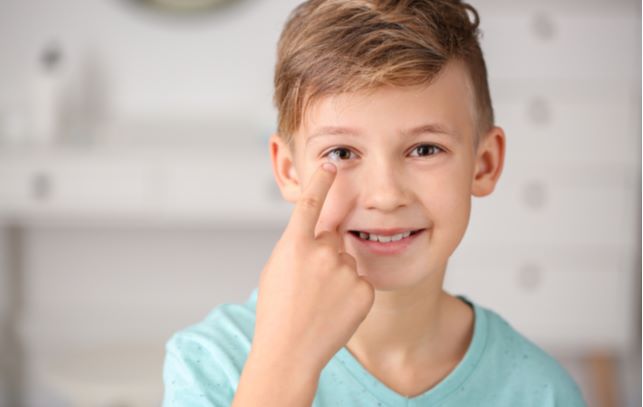Myopia is one of the world’s most common vision problems. It usually emerges early on in life, and can continuously progress and worsen over time.
Golden Hills Optometry offers effective myopia control treatments in San Jose that can help your child retain healthy and clear eyesight over their lifetime.
5 tips to help slow myopia progression in kids include:
- Regular eye exams
- Using multifocal contact lenses
- Atropine eye drops
- Orthokeratology
- Spending more time outdoors
If you are concerned that your child is experiencing myopia, please do not hesitate to book an appointment to get their eyes examined—we are here to help!
What is Myopia?
Myopia, or nearsightedness, is a condition of the eye in which objects further away will appear blurry and distorted. This is due to the elongation of the eye causing light to refract incorrectly—when someone is myopic, light that enters the lens of their eye will converge at a point before reaching the retina rather than converging directly onto the retina.
Symptoms of myopia can include:
- Blurry vision when viewing distant objects
- Needing to squint or partially close the eyelids to see clearly
- Headaches
- Difficulty seeing while driving a vehicle (especially at night)
Risk factors that can influence the development of myopia are:
- Genetics—myopia tends to run in families. If one parent has myopia, the risk of their child developing the condition is increased. This risk is even higher if both parents are myopic.
- Environmental conditions—not spending enough time outdoors may increase the chances of developing myopia.
Myopia Control in San Jose
Myopia typically emerges early on into adolescence and is a common condition amongst children with refractive problems. Myopia control is the process of managing myopia in children and ensuring that the progression of myopia slows down through controlled treatment.
While myopia cannot be cured or reversed, the goal of myopia control is to slow the progression of myopia and ensure that your child’s eyes are protected for the future.
How to Slow Myopia Progression
If your child is experiencing myopia, we offer a range of different myopia control methods to help manage their condition.
1. Start With an Eye Exam
Before conducting any myopia control methods, it is recommended that your child receives a comprehensive eye examination. An eye examination will reveal the specific vision problems that your child is experiencing, and will help give your eye doctor insight into your family’s health history. These discoveries will help your eye doctor determine the most effective myopia control treatment suited to your child’s needs.
An eye examination will also help discover the prescription your child will need if they require contact lenses or eyeglasses to correct their problems with myopia.
2. Multifocal Contact Lenses
These lenses are typically worn by children aged 6–12 to help control myopia. The lenses are specially designed to have different powers of refraction (prescriptions) on one single lens. The different powers on the lens are aligned like a dartboard—the center of the lens is designed to help your child see objects far away in the distance, while the outer powers defocus your child’s peripheral vision. Defocusing peripheral vision is thought to slow eye growth and the progression of myopia.

3. Atropine Eye Drops
Atropine eye drops can be used to slow the progression of myopia in children aged 5–18. These drops take about 2–3 years of continued use to slow down the development of myopia. It is recommended that your child uses the drops every night before bed.
It is not entirely known why these drops slow the progression of myopia, but doctors believe that it could be due to the eyeball becoming less elongated over time through the continued use of the drops.
4. Orthokeratology (Ortho-K)
Orthokeratology, or ortho-k, are special contact lenses that your child will wear overnight to slow the progression of myopia. The lenses work by subtly reshaping your child’s cornea by flattening it.
If this method of myopia control is chosen by you and your child, it is important to remember that your child will need to consistently use the contact lenses at night for the best possible results. If the lenses are not worn consistently, your child’s eye or eyes will revert to their myopic state.
5. Spend More Time Outdoors
Spending less time indoors or in front of screens can help slow the progression of myopia. Having varied scenery to look at and healthy exposure to natural light will ensure that your child’s eyes can develop properly.
Early Detection Equals Effective Prevention
The earlier that you discover your child has myopia, the better. If treatment for myopia starts during adolescence, your child’s eyes have a much better chance of developing stronger and healthier over time.
Once again, it is important to make sure your child is receiving regularly scheduled eye examinations. These examinations will ensure that the myopia control treatments for your child will be effective and suited to their specific needs.



